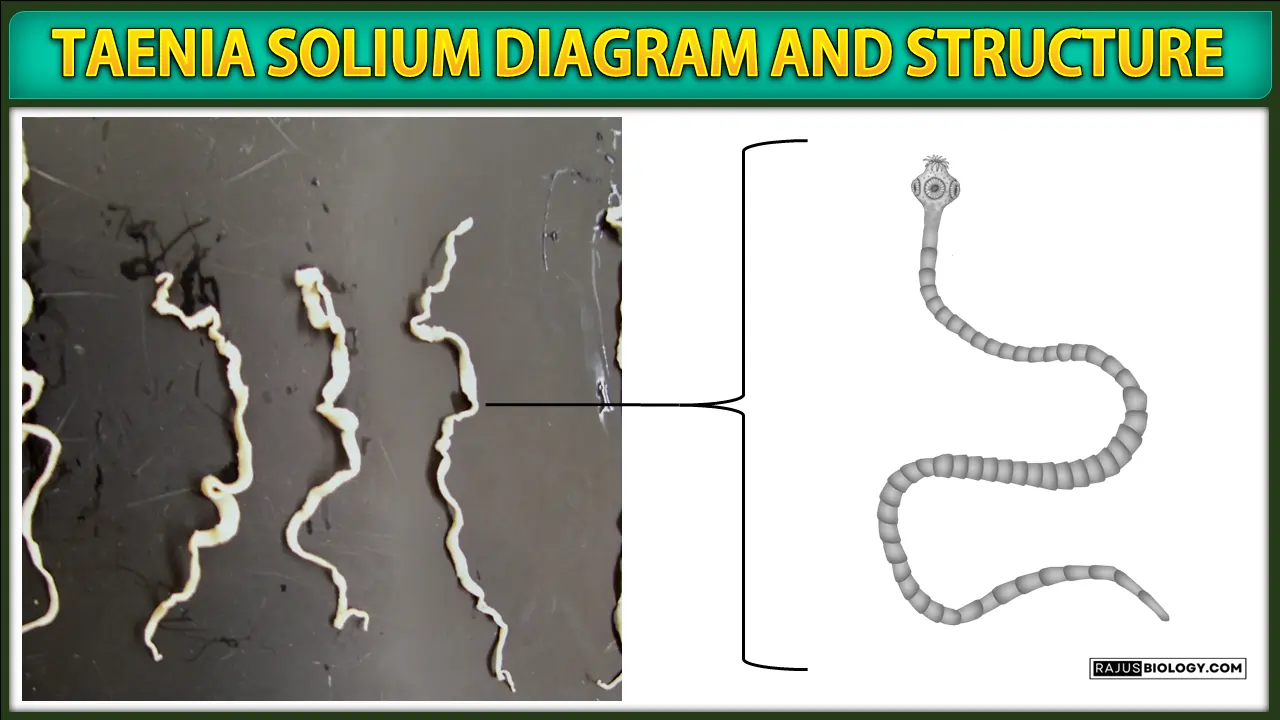In this article we will discuss about taenia solium diagram, structure and reproduction
Taenia solium Diagram

How to Draw a Taenia solium Diagram
Structure of Taenia solium
- Scolex (Head): The scolex, also known as the head of Taenia solium, is a small, round structure located at the anterior end of the tapeworm. It is equipped with various adaptations that allow the parasite to attach itself to the lining of the host’s intestines.
- Hook: The hook is a specialized structure found on the scolex of Taenia solium. It is shaped like a tiny, sharp hook and is used to anchor the tapeworm firmly to the intestinal wall of the host. The presence of hooks helps the parasite maintain its position and prevents it from being dislodged.
- Sucker: The sucker is another feature present on the scolex of Taenia solium. It is a circular, muscular structure that functions as a suction cup. The sucker attaches to the intestinal wall by creating a vacuum, further securing the tapeworm in place.
- Neck: The neck is the elongated region of the tapeworm located just behind the scolex. It serves as the connecting link between the scolex and the body of the tapeworm. The neck is responsible for the continuous production of new proglottids, which are the reproductive segments of the tapeworm.
- Immature proglottid: The immature proglottid is one of the segments that make up the body of Taenia solium. These segments are initially small and underdeveloped. As they mature, they gradually increase in size and complexity.
- Mature proglottid: The mature proglottid is a fully developed segment of the tapeworm’s body. It is larger and more complex compared to the immature proglottid. Each mature proglottid contains male and female reproductive organs, making it capable of producing eggs and continuing the life cycle of the tapeworm.
Reproduction in Taenia solium
Reproduction in Taenia solium occurs through two distinct types: asexual reproduction within the tapeworm itself and sexual reproduction between different tapeworm individuals.
I. Asexual Reproduction:
Asexual reproduction takes place within the tapeworm’s body through a process called budding. The neck, a region located just behind the scolex (head) of the tapeworm, plays a crucial role in this process. The neck continuously produces new segments known as proglottids. These proglottids start off as immature and underdeveloped, but as they move away from the neck, they gradually mature and become fully functional reproductive units.
Each mature proglottid contains both male and female reproductive organs, making Taenia solium a hermaphroditic species. This means that an individual tapeworm possesses both male and female reproductive capabilities within its own body. The mature proglottids are responsible for producing eggs, which are released into the environment through the feces of the host.
II. Sexual Reproduction:
However, for sexual reproduction to occur, Taenia solium relies on an intricate life cycle that involves two different hosts. The first host is typically a pig, which becomes infected by consuming food contaminated with tapeworm eggs. Once inside the pig’s intestines, the eggs hatch, and the larvae penetrate the intestinal wall and migrate to various tissues, forming cysts known as cysticerci.
Now, here comes the crucial part of the life cycle. If a human consumes undercooked or raw pork infected with cysticerci, the cysticerci develop into adult tapeworms within the human’s intestines. Sexual reproduction takes place when these adult tapeworms release eggs through their mature proglottids, which are then passed out of the human host through feces.
The cycle comes full circle when pigs, or other intermediate hosts, ingest the tapeworm eggs present in the environment. The eggs hatch inside the pig’s digestive tract, and the larvae migrate to the pig’s tissues, forming cysticerci once again. This completes the cycle, allowing Taenia solium to reproduce and continue its life cycle.
It is worth noting that while Taenia solium’s life cycle is intriguing, it poses significant health risks to humans. Ingesting undercooked or raw pork infected with cysticerci can lead to the development of cysticercosis, a potentially serious condition characterized by the formation of cysts in various organs. Therefore, proper cooking and hygiene practices are essential in preventing the transmission.
Read More:
Diversity in the living world notes



![[PPT] The living world Class 11 Notes](https://rajusbiology.com/wp-content/uploads/2024/06/PPT-The-living-world-Class-11-Notes-300x169.webp)
